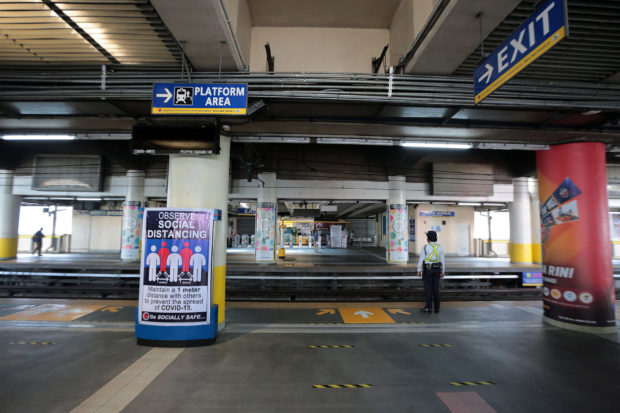
NOT ALL ABOARD Social distancing will be part of the new norms on the metro after the lockdown in Metropolitan Manila, but the government and private operators of the three elevated light-rail lines in the capital region have yet to announce how they plan to control boarding at the usually crowded stations. With nobody controlling boarding at the train doors, social distancing signs like the one shown at the MRT 3 North Avenue station in Quezon City in the picture above will not beenough to prevent overcrowding on trains. —GRIG C. MONTEGRANDE
MANILA, Philippines — In line with the easing of quarantine protocols in various areas in the country, railway transport operations will resume with limited capacity.
While railway operations are set to resume—particularly the Light Rail Transit (LRT) Lines 1 and 2, Metro Rail Transit-3 (MRT-3), and the Philippine National Railways (PNR)—protocols will remain in place as the country continues to grapple with the coronavirus disease (COVID-19) pandemic.
According to the guidelines released by the Department of Transportation (DOTr), strict health and safety protocols will be firmly enforced in railway operations under a general community quarantine.
Among these guidelines are as follows:
Mandatory passenger health screening
- Thermal scanning of passengers to ensure no passenger exhibits temperature above 37.8 degrees Celcius or higher.
- Train passengers will pass through a shoe foot bath, hand washing, and hand disinfection, to ensure proper hygiene and sanitation.
- Train passengers will be screened to ensure that only authorized persons outside residence (APORs) are permitted entry.
- Passengers identified to be symptomatic will be directed to an identified isolation area.
Passenger riding capacity
- A 1-meter physical distancing between passengers inside trains and in stations will be implemented, resulting in a limited capacity. Social distancing will be implemented on station platforms, in concourses, and inside elevators and escalators, to avoid passenger concentration.
- Skip trains or trains bypassing certain stations may be dispatched to manage passenger volumes;
- A Block System will also be implemented to control the entry of passengers into stations, platforms, and into trains.
Assurance of safety of train personnel
- Train personnel will be screened for COVID-19 symptoms to address the risk of them being the source of transmission.
- Personnel will be observed and symptoms logged twice daily, to ensure that they have no symptoms in the course of their assignment.
- Individuals are twice daily observed and symptoms logged in to ensure no train personnel is asymptomatic once they are on assignment.
Train sanitation measures
- Handwashing/ disinfectant stations will be installed
- Regular disinfection and sanitation of train interiors, station premises, and facilities
- All trains every half loop will be cleaned and disinfected within (5) five minutes
- All surfaces will be wiped with chlorine-based disinfectant
- All Train Marshalls shall enforce sanitary and health protocols to avoid pax to pax transmission during train trips
- Constant reminder to passengers on maintaining proper social distancing
- Passenger flow will be maintained to increase headway and allow higher capacity
- Use of Public Address (PA) system for announcements; TV screens in stations and in trains where available and print materials to be posted in strategic locations to provide information to the riding public
The DOTr also said that the following passengers will not be allowed to enter train stations:
- Passengers who are not wearing appropriate face masks
- Passengers exhibiting COVID-19 symptoms or has registered body temperature of 37.8 degrees Celsius or higher.
- Senior citizens, persons aged 0-20, and pregnant except when indispensable under the circumstances for obtaining essential goods and services, for work in industries and offices, or such other permitted activities
“To prevent the rail lines from becoming transmission vectors, and thus, ensure the safety and well-being of passengers, these guidelines and protocols have been put in place,” DOTr said.
Starting June 1, areas such as Metro Manila, Cagayan Valley, Central Luzon, Calabarzon, Pangasinan, Albay, and Davao City will be under GCQ after more than two months of strict movement restrictions to prevent the further spread of the novel coronavirus.
In areas placed under GCQ, road, rail, maritime, and aviation sectors of public transportation shall operate at a reduced operational and vehicle capacity, given that minimum health standards are observed.